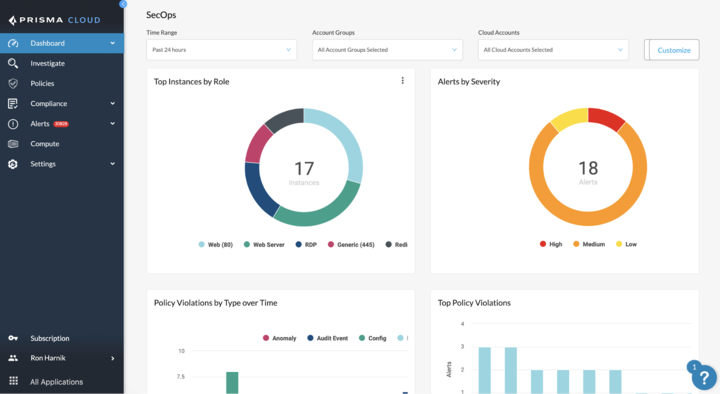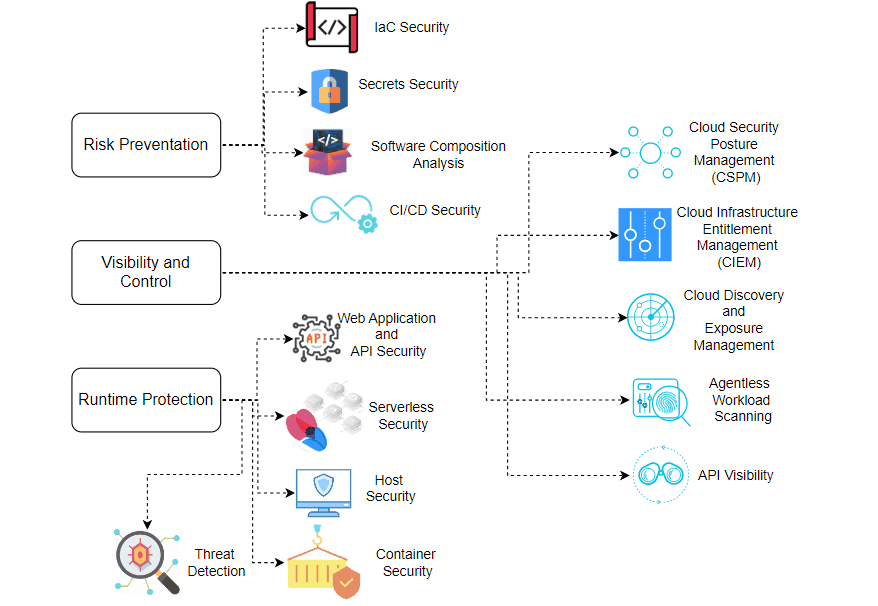Cloud adoption is accelerating, but so are the security risks. Misconfigurations, identity breaches, and data leaks can bring businesses to a halt.
Traditional security tools aren’t sufficient for today’s multi-cloud and hybrid environments. Prisma Cloud by Palo Alto Networks addresses this challenge by securing the entire application lifecycle from code to runtime while ensuring compliance and real-time threat detection.
In this guide, you will learn what Prisma Cloud is, how it works, its key features, benefits, limitations, and why it’s becoming essential for cloud security.
What is Prisma Cloud?

Prisma Cloud is a strong all-in-one cloud-native application protection platform (CNAPP) by Palo Alto Networks. It helps organizations to mitigate risks associated with applications, data and infrastructure in public, private, hybrid and multi-cloud environments.
Unlike traditional security tools that focus on one layer Prisma Cloud integrates multiple security capabilities into one platform and provides end-to-end protection. It secures everything from development phase (code) to runtime.
With Prisma Cloud you get:
- Visibility into all cloud resources and workloads.
- Real-time detection of misconfigurations, vulnerabilities and threats.
- Compliance for industry standards like GDPR, HIPAA and PCI DSS.
- Automated remediation to reduce security risk with no manual effort.
In short, Prisma Cloud is an all-in-one security layer that secures your cloud infrastructure, applications and data throughout their lifecycle.
How Does Prisma Cloud Work?

Prisma Cloud is an integrated security platform that continuously monitors, detects and protects your cloud environment from development to deployment. Here’s how it works in simple terms:
1. Visibility Across the Entire Cloud
- Prisma Cloud scans your cloud accounts, workloads and applications.
- It provides you a complete inventory of resources, users, permissions and data flows.
- Detects misconfigurations or risky settings before they can be exploited.
2. Shift-Left Security in Development
- It integrates with your CI/CD pipelines to catch vulnerabilities early in the software development process.
- It scans Infrastructure as Code (IaC) templates like Terraform, Kubernetes or CloudFormation for misconfigurations.
- It identifies and protects sensitive information like exposed secrets or API keys.
3. Runtime Protection for Applications
- It monitors live containers, virtual machines, APIs and serverless functions running in the cloud.
- It detects suspicious behavior, malware or unauthorized access in real time.
- It automatically blocks attacks before they can cause damage.
4. Compliance and Risk Management
- It continuously checks your cloud setup against compliance standards (GDPR, HIPAA, PCI DSS).
- It generates easy to understand reports for audits and regulatory requirements.
5. Automation and Threat Intelligence
- Finds even new and unknown attacks with the help of machine learning and Palo Alto Networks’ threat intelligence.
- Takes instant action automatically, isolating affected workloads, removing risky access, and fixing misconfigurations without you lifting a finger.
Prisma Cloud essentially serves as a security guardian for your whole cloud lifecycle, from creating code to operating it in production.
Recommended Read: What is 5G Network Security? A Complete Guide
Key Features of Prisma Cloud
Prisma Cloud unifies several security features on one platform. Its most significant characteristics include:
1. Management of Cloud Security Posture ( CSPM)
- It searches public, private, and hybrid cloud misconfigurations.
- It supports adherence to industry requirements including PCI DSS, HIPAA, and GDPR.
- It offers immediate insight into cloud hazards.
2. Cloud Workload Security (CWP)
- It protects serverless functions, virtual machines (VMs), and containers.
- It scans for suspicious behavior to stop illegal access and finds image flaws to stop runtime attacks.
3. Infrastructure as Code (IaC) Security
- Before deployment, it studies Terraform, Kubernetes, and CloudFormation templates.
- Early in development, it finds security problems to prevent unsafe setups from going live.
4. Security of the CI/CD Pipeline
- It checks code, secrets, and dependencies by integrating with DevOps tools.
- It automatically secures build and distribution pipelines and lowers the attack surface in the software supply chain.
5. Access and Identity Protection
- It reviews user rights, roles, and privileges across cloud accounts.
- It guarantees least-privilege access to reduce internal threats and detects erratic access patterns or too many privileges.
6. API and Database Security
- It shields API endpoints from assaults and abuse.
- It scans cloud data for exposure hazards and sensitive information leaks.
7. Reporting and Compliance
- It creates audit-ready reports for simple governance and certification including inbuilt compliance frameworks such SOC 2, NIST, ISO, and PCI DSS.
8. Automation and Threat Intelligence
- It supports AI-driven threat detection using Palo Alto Networks’ worldwide intelligence.
- It automates incident response to rapidly close weaknesses.
Advantages of Prisma Cloud
- From code to deployment, End-to-End cloud security safeguards the entire cloud life cycle.
- One location for a unified platform brings together multiple security solutions including CSPM, CWP, IaC, CI/CD, and identity.
- Enhanced compliance guarantees adherence to GDPR, HIPAA, PCI DSS, and other regulations.
- Shift Left Security spots and fixes weaknesses early in the development.
- Reduced Attack Surface identifies misconfigurations, excessive permissions, and unsecure APIs.
- Faster threat detection and response uses artificial intelligence-driven monitoring and automatic fixes.
- Cost Savings obviates several individual security systems.
- Scalability works across multi-cloud, hybrid, and complicated DevOps setups.
Step-by-Step Prisma Cloud Operation
1. Search and Awareness
- It checks your cloud environments like AWS, Azure, and GCP by default.
- It finds every asset, job, identity, API, and setting.
2. Detect Risk and Misconfigurations
- It discovers policy violations, compliance gaps, and misconfigurations.
- It brings attention to exposed resources, low IAM roles, and potential attack routes.
3. Identifying and Monitoring of Threats
- It constantly scans workloads, containers, and APIs for anomalous activity using behavioral analysis and threat intelligence to spot attacks.
4. IaC (Infrastructure as Code) Scanning
- Before deployment, it validates other IaC templates, Terraform, Kubernetes YAML.
- It stops flaws and misconfigurations from reaching production.
5. Runtime Safeguarding
- It guards serverless functions, Kubernetes clusters, and running containers.
- It finds runtime irregularities like privilege escalations or malicious code execution.
6. Reporting and Compliance
- It creates automated reports for governance and audits by comparing your cloud security posture against criteria like GDPR, PCI DSS, and HIPAA.
7. Remediation and Enforcement
- It suggests solutions for vulnerabilities and misconfigurations.
- It can automatically implement policies including blocking of dangerous deployments.
Challenges and Limitations of Prisma Cloud
- Particularly in large multi-cloud or hybrid settings, Prisma Cloud can be challenging to set up.
- Teams may need training to correctly use all its functions; it has a learning curve.
- For small companies, if they activate every available module, the cost can be rather significant.
- Certain characteristics may coincide with already installed security measures in a company, therefore creating redundancy.
- Still, continuous monitoring and management are necessary to guarantee performance and security.
Final Thoughts
Prisma Cloud helps companies protect applications, infrastructure, and workloads across any cloud environment, Cloud is a strong, all-in-one cloud-native security solution. Although it might have a learning curve and certain financial factors, its all-compassing approach to visibility, compliance, and threat prevention makes it a best pick for contemporary cloud security.
Solutions like Prisma Cloud will become even more crucial in protecting data and guaranteeing compliance as companies keep using hybrid and multicloud settings.
Prisma Cloud is something to think about if you want to keep ahead of changing threats and preserve your whole cloud ecosystem.
If you’re exploring cloud security solutions, Prisma Cloud is worth considering for comprehensive protection now and in the future.
Visit our Cyber-security page; we have the best guides for you. If you’re interested in contributing, submit your guest post and Write for Us.
FAQs
Is Prisma Cloud difficult to implement?
Prisma Cloud can be complex for large multi-cloud or hybrid environments and may require team training, but it provides robust security once fully implemented.
What are the benefits of Prisma Cloud?
It improves cloud visibility, reduces security risks, ensures compliance, detects and fixes vulnerabilities early, and simplifies cloud security with a unified platform.